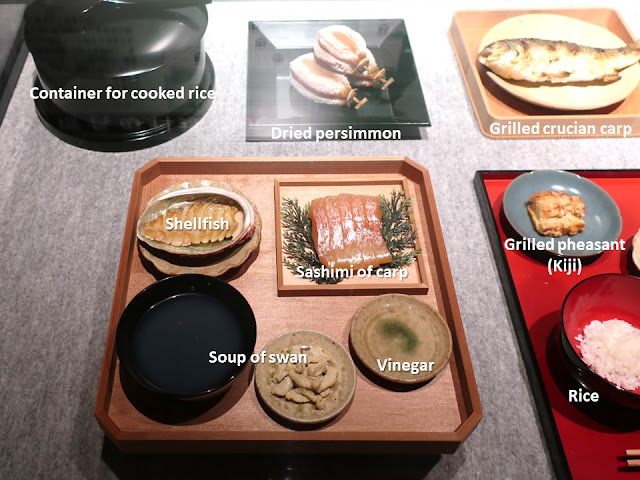Gifu City is famous for Ukai (cormorant
fishing) and Oda Nobunaga (feudal warlord, 1534-1582). Nobunaga was the
very powerful war lord who tried to unify Japan during the internal war time.
He is also famous as the hero of “Nobunaga's Ambition“ (video game). He
moved his HQs from Nagoya to Gifu in 1567. He stationed just nine years and
moved to Azuchi (Azuchicastle museum) which is closer to Kyoto where the emperor resided. Many
tourists who are interested in Nobunaga visit Gifu even until now. The city is
designated as “Japan Heritage” (A Ruthless Warlord’s Spirit of Hospitality).
岐阜市の観光は織田信長と鵜飼いですね。1567年に尾張・清須城から拠点を移した信長が岐阜にいたのは9年間。でも、今も信長を慕って岐阜を訪ねる人は多いです。「『信長公のおもてなし』が息づく戦国城下町・岐阜」として、日本遺産の認定を受けています。
The photo above is the view of the castle at dawn. Do you know where is the castle tower? It’s at the summit (329m) behind Nagara River.
日が昇る直前の岐阜城です。天守閣がどこにあるか分かりますか? 長良川の向こうの金華山の山頂、標高329mにあります。
I crossed the river and took the photo above from the ropeway station. The castle was built in the 13th century and Nobunaga renovated it as the base to unify Japan. The title of the brochure is ”The Castle of Nobunaga’s Dream”. The castle was abandoned after the internal war time and was rebuilt in 1956.
長良川を渡ってロープウェイ乗り場がある岐阜公園から見た岐阜城。13世紀の初めに城が作られましたが、信長が16世紀半ばに入城し天下統一の拠点として改築しました。リーフレットの英文タイトルは”The Castle of Nobunaga’s Dream”。関ヶ原の戦い後に廃城になり、現在の天守閣が作られたのは1956年です。
The first gate. Excavation and research are done at the castle site.
一ノ門です。そこここで発掘調査が行われています。
The castle tower has the stone wall from the time of Nobunaga. There is a ruin of a rainwater cistern on the left side of the tower.
天守閣が見えてきました。信長時代の石垣も残っています。また、この左側には雨水を貯める井戸跡があります。
The view of Nagara River and Noubi Plain from the castle tower.
天守閣から長良川、濃尾平野の眺めです。
There are mountains in upstream.
上流側は、美濃の山中に続いていきます。
Inside the castle is the museum about Nobunaga.
城内は織田信長博物館です。
Nobunaga's Hospitality is elaborated as follows.
"--- (He) changed the role of the castle from being merely a military facility, to becoming a display of his power and authority, and to create an idyllic area in which to showcase his hospitality to all visitors. Many influential people, including envoys and aristocrats from Kyoto, messengers of The Warring States feudal lords, and missionaries from Portugal, visited Gifu to meet Lord Nobunaga, and received the warmest of hospitality of Nobunaga, overturning his once cold-hearted image. ---".
The panel on the right shows dishes while Nobunaga entertained visitors. Those are exhibited at Gifu City Museum of History.
信長は、城下一帯を最高のおもてなし空間としてまとめあげ、武田信玄の使者や公家、ルイス・フロイトを迎えました。鵜飼いを見せるのもその一つで、彼は「鵜匠」の名を与え、鵜飼いを保護しました。信長の冷徹なイメージを覆すようなおもてなしだったということです。信長料理復元模型(岐阜歴史博物館)の写真もパネル展示されています。
The photo above is the exhibit in Gifu City Museum of History. Nobunaga showed his vaunted tea ceremony set and held a tea ceremony to entertain Sougyu with tea and food in February of 1574 (Sougyu was an influential merchant in Osaka and was also an expert in a tea ceremony). The models of the dinner during the tea ceremony are exhibited. Nobunaga’s sons served dishes and Nobunaga brought sake bottles by himself. (He asked huge donation to Sougyu later.)
岐阜市歴史博物館の展示品がこちらです。1574年2月3日に信長の接待を受けた堺の商人で茶人の津田宗及の記録をもとにした再現模型です。
信長は、宗及が所望する茶道具を見せた後、茶会を開き、料理でもてなしました。信長の息子たちが給仕を担当し、信長自ら銚子を運んだそうです。信長は後に莫大な資金を宗及に要求しています。
The foods on the third course are very interesting. Swan was the excellent ingredient back then. They ate the soup and the swan meat separately. (It is prohibited to catch swan now.) They dipped the sashimi (raw fish) of the carp into the vinegar, because soy sauce was not developed back then.
三の膳が珍味です。まず、「生白鳥汁」。「この時代、白鳥はたいへんなご馳走でした。肉は取り皿で、汁とは別に食べました」とのことです。醤油が開発されてなかったので、鯉の刺身には酢を付けて食べました。
Residence at the foot of the mountain、城下の居館
There are ruins of Nobunaga’s residence near the ropeway station.
ロープウェイの下には信長の居館跡があります。
The signboard at the site shows the image of the residence. Portuguese missionary Luis Frois wrote it seemed to be a paradise. Visitors looked around the luxurious buildings and gardens. Nobunaga also entertained them by dancing, singing and dinner.
居館のイメージ図の看板がありました。山麓の居館では、訪問者が建物や庭の見学、踊りと歌の饗応、食事を受けました。ルイス・フロイトは「地上の楽園」のようであったと記しています。
Visited
in January, 2022
Website
of Gifu travel guide: https://www.kankou-gifu.jp/spot/912/ (in Japanese), accessed in
May, 2022
Previous post (Museum in the same
prefecture) : Ogaki local museum、大垣市郷土館
Next post (Museum at the foot of the castle): Gifu City Museum of History、岐阜市歴史博物館













Comments
Post a Comment